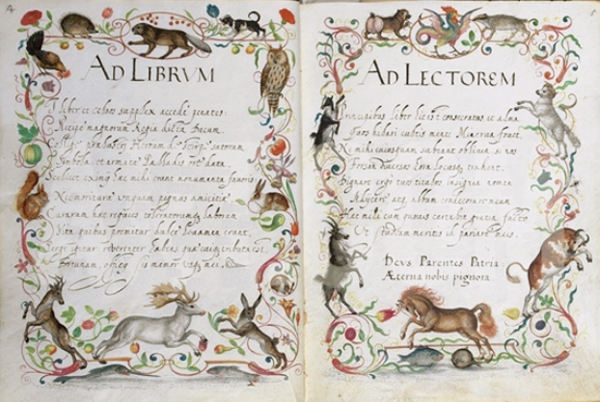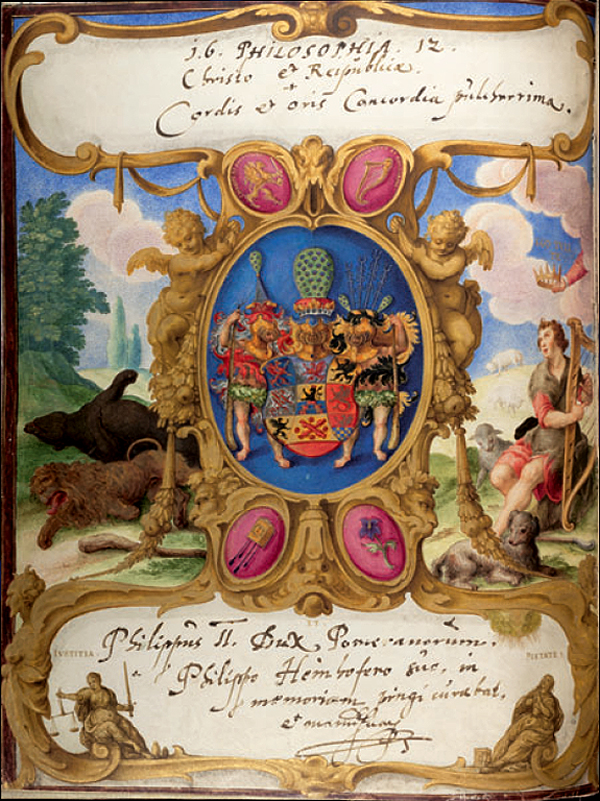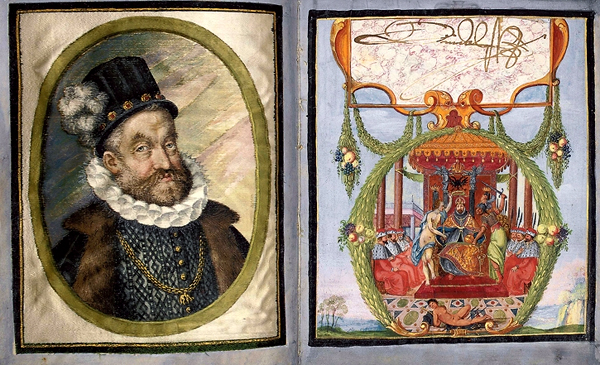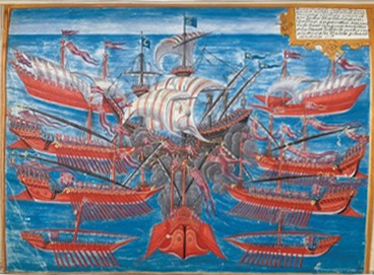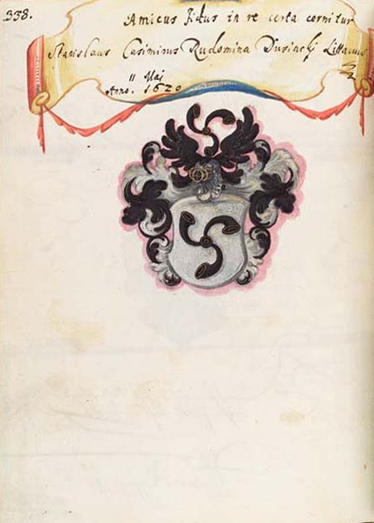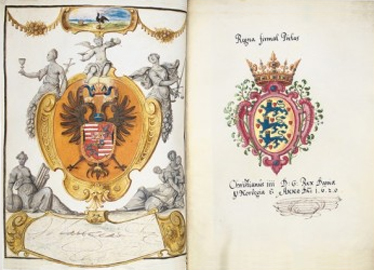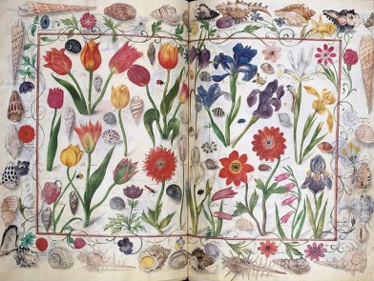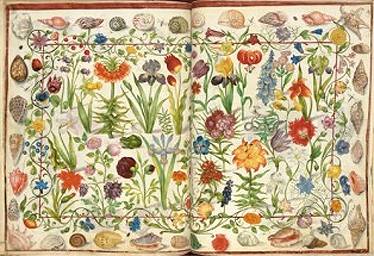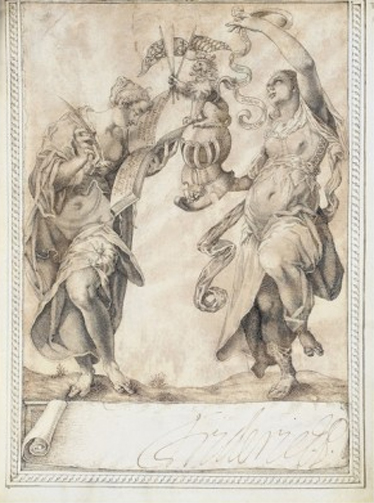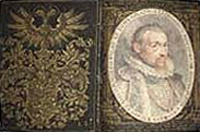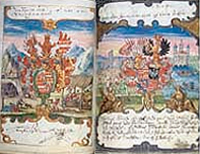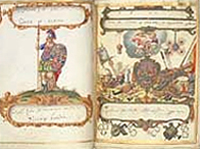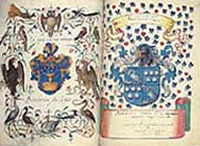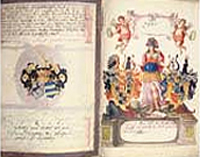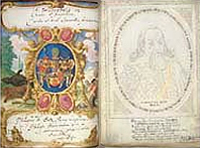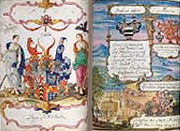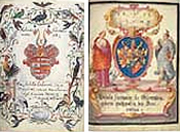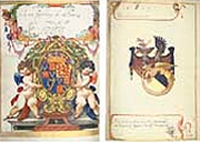BIBLIOTHECA AUGUSTANA
Philipp Hainhofer
1578 - 1647
Album amicorumGroßes Stammbuch
1596-1633
Auction at Christie's 2006Realized Price: $2,368,000DescriptionIllustrations
|
|
|
____________________________________________________________
|
|
Album amicorumDas grosse Stammbuch of Philipp Hainhofer,in German, Latin, French and Italian,Illuminated manuscript on vellum and paper.Germany, Italy and Bohemia, 1596-1633.
Description
208 x 160mm. 10 prefatory paper leaves, 108 leaves including nine blanks, 13 paper leaves and two card leaves; two leaves with pasted-on embroidered panels, one with a painting on silk, one with a drawing laid-down, one with a painting laid down and one with a print laid-down, 10 final paper leaves; 6 of the front prefatory leaves and six of the final leaves of Turkish paper (ebru); paginated 1-227 starting with title-page (occasional slight rubbing or creasing, a few leaves with inconsequential spotting or stains, a few leaves loosening on guards). Red velvet over wooden boards, leaves often mounted on guards, and sewn onto four double cords which loose through boards, red velvet wrapper secured by cords. Red morocco box.
A renowned 'book of friendship' reappears:a monument to the princes of Europe and court artat the advent of the thirty years war
The Collector:
Philipp Hainhofer (1578-1647), was an internationally influential figure. After studying in Padua, Cologne and the Netherlands he followed his father's example and set up as a cloth merchant in Augsburg, his native city. He expanded his trade beyond the Italian silks that were its mainstay to encompass all luxury goods. His princely clients were quick to recognise the wider service that his education, charm and intelligence could offer. He was soon employed not only as an art advisor and supplier but as a political agent. He travelled widely to carry out diplomatic and ceremonial duties: the contacts he made with the princes of Europe are recorded in the signatures of the present manuscript. These contacts and duties are more discursively documented in Hainhofer's surviving travel journals and in his correspondence with his patrons: these sources also chronicle the history of his Stammbuch: O. Doering, 'Des Augsburger Patriciers Philipp Hainhofer Beziehungen zum Herzog Philipp II von Pommern-Stettin: Correspondenzen aus den Jahren 1610-1619', Quellenschriften für Kunstgeschichte und Kunsttechnik, n.s., vi (1894) and 'Des Augsburger Patriciers Philipp Hainhofer Reisen nach Innsbruck und Dresden', ibid., x (1901).
The Book:
The fashion for assembling Alba Amicorum (Books of Friendship) appears to have started among German students in the middle of the 16th century. At first the signatures of those they met on their travels were collected in the margins of readymade books, sometimes printed emblem books and sometimes blank albums. Gradually they became more individual, ad hoc creations: Turkish papers and Venetian costume paintings, were particularly popular additions to the pages of autographs, emblems and heraldry. But there can be no other that compares with Hainhofer's collection. It was regarded during his lifetime as one of the sights that any discerning visitor to Augsburg should see, this 'uberaus künstliches Stammbuch, dergleichen wol nirgents solle gesehen werden'.
He had first started collecting signatures and coats of arms when he was 15. It became a joint project with his father and brothers to put together a great collection, to make 'ein Denkmal des gegönnten Gunst, ein Pfand der unsterblichen Freundschaft, eine Erquickung nach der Sorgen und Mühen des Lebens'. Before long he had taken sole charge and he continued to collect throughout his life. By his later years there were five Stammbücher, three of them more modest collections (two devoted to Augsburg families, now in the Stadtbibliothek of the city, and a small travel Stammbuch in the Herzog August Bibliothek, Wolfenbüttel). The most important, the Stammbuch where the signatures and arms of those of higher rank and prestige were gathered, was divided into two in 1613: Hainhofer had decided to grade his ever-growing collection, henceforth the Grosse Stammbuch would be for princely persons and the Kleinere for 'nobles, patricians and good friends'. The latter was part of the literary estate that Augustus, Duke of Brunswick-Lüneburg bought after Hainhofer had lost his fortune and been forced to sell what he could during the Thirty Years War: it remains in the library at Wolfenbüttel. At the time of Doering's publication of Hainhofer's correspondence and travel diaries the Grosse Stammbuch was believed to have been lost. It eventually resurfaced in the catalogues of Bernard Quaritch Ltd, London in 1931, where it was item 99, and again in 1941, as item 2. It was purchased by H.P. Kraus who sold it to Cornelius Hauck in 1946. The re-emergence of the Stammbuch has hitherto escaped scholarly attention; with the great growth of interest in Rudolfine art in the past three decades it has been extensively discussed as a 'lost' work. Well documented but unstudied, containing fine examples of the work of leading artists of its time, the Stammbuch is an invaluable resource for increasing the understanding of court art and its protagonists during this turbulent period.
Hainhofer's descriptions or the signatures on the works enable paintings or drawings by Lucas Kilian, Anton Mozart, Tobias Bernhard, Jacopo Ligozzi, Georg Behem, Johann Mathias Kager and Joseph Heintz to be certainly identified among the pages of this Stammbuch: further study will no doubt establish the authorship of many of the other svelte and inventive creations that make up this remarkable manuscript.There are groups of leaves that are clearly the work of artists of especial note who are, as yet, unidentified: for example, the accomplished and appealing paintings on pages 59, 62, 69, 109 and 195; and the somewhat later confections of great refinement and fantasy on pages 106, 152, 153 and 190.
Perhaps the most tantalising of the unassigned leaves are the 'natural history' pages where precisely studied and represented birds, animals, insects or shells are artfully combined to form borders. These are around pages 4, 5, 131, 137, 140, 179 and 182; Hainhofer called these 'rodeschen werck'. The other sides of four of these, the double pages 138/139 and 180/181, are overspread with flowers within such borders. Meticulous, elegant and delicate these pages inevitably recall the work of Joris Hoefnagel (1542-1600). They appear to have been bought as a group and given out by Hainhofer at different times for signature and heraldic addition: the earliest inserted signature is dated 1596, within the lifetime of Hoefnagel. Hainhofer does not name the author of these pages, although in 1611 he includes 'Hufnagel' among the painters whose work is to be found in his Stammbuch: Doering, 1901, p.282.
By the time of his death Hainhofer had given away or sold some of the pages he had described and they are no longer to be found in either this Grosse Stammbuch or in the lesser volume in Wolfenbüttel. It is clear that he retained the pages that had most importance to him, whether because of the high quality of the art or of the high status of the signatory. His three greatest patrons, Philipp of Pomerania-Stettin (pp.36 & 37), Augustus, Duke of Brunswick-Lüneburg (p.58) and Leopold V, Archduke of Austria (p.41), are represented alongside Cosimo de' Medici, the Emperors Rudolf II and Matthias. They are brought together with kings, queens and princes -- Protestant and Catholic -- from opposing sides in The Thirty Years. The book is a fascinating historical document recording the movements, rival claims and changing fortunes of the rulers of Europe. But it is rather the quality of the drawing and painting in these pages, the range and variety that ensures that the 1620s assessment that its equal is not to be found remains true today. Hainhofer is best known for the cabinets he designed and assembled for his princely patrons; they served as miniature Kunst- or Wunderkammern. Combining the work of numerous artists and craftsmen, they encapsulated the wealth of the natural world and the range of human achievement: the varied pages of the present manuscript, exemplifying the finest court art of his day, can be justifiably regarded as a portable and personal equivalent of such a Kunstkabinet.
Signatories and illustration:
p.1: Title-page, dated 1600, with three quotations, in French, Italian and Latin in appropriate scripts, within a fully painted border with instruments of peace -- the arts and sciences -- and of warfare against a black background, Hainhofer's name and coat of arms in a strapwork surround.pp.4-5: Latin poems addressed to the book and the reader within a painted border of prancing animals leaping over tendrils of fruit and flowers, birds at the top and fish below. Described by Hainhofer as 'rodeschen werck von allerlay thieren, bluemen und früchten, die 4. elementa und 4. Zeiten dess Jahrs bedeuttent'.p.8: Johann III Schweickard von Kronberg, Archbishop-Elector of Mainz and Arch-Chancellor of the Holy Roman Empire (1553-1626). An ink and wash drawing of travellers in a landscape signed with the monogram of Anton Mozart of Augsburg (1573-1625). The landscape is drawn around a central medallion with the Archbishop-Elector's achievement of arms painted in full color, and two cartouches containing the pasted-on motto and signature of the Archbishop.p.10: Ladislaus Sigismund, Crown-prince of Poland (1595-1648), ruled as Ladislaus IV from 1632. His signature within a zoomorphic cartouche and his coat of arms on an emblematic painting with motto, dated 1624.p.13: Gustavus Horn (1592-1657), Fieldmarshal and Commander of the Swedish army in Germany. His coat of arms, motto and signature dated 25 March 1633 in Augsburg. The city had capitulated to the Spanish troops in April 1632. The reinstated Protestant councillors bought the Uppsala cabinet from Hainhofer for presentation to the Swedish king. It was shipped to Sweden in 1633 and is the only cabinet to survive with its contents intact.pp.16-17: Rudolf II, Emperor Rudolf II (1552-1612). His portrait on white silk by Daniel Fröschl (or Fröschlein), court miniaturist and court antiquary to Rudolf, pasted onto p.16 and facing Rudolf's signature pasted onto p.17 and incorporated into a setting with a landscape background and a central scene framed with swags showing the Emperor flanked by two allegorical figures and the seated Electors.p. 20: Archduke Matthias of Austria (1557-1619), administrator of the Hapsburg territories and Emperor from 1612. His signature pasted onto a cartouche below his achievement of arms painted in full color and surrounded by four Virtues painted in monochrome.p.21: Christian IV (1577-1648), King of Denmark and Norway 1588-1648. His achievement of arms with his motto above and signature below, dated 1620.p. 24: Elizabeth Stuart, princess royal of England, (1596-1662), wife of the Elector Palatine, Queen of Bohemia ('The Queen of Hearts' or 'Winter Queen'). Her motto and signature, dated 1616, in an elaborate painted cartouche above her achievement of arms supported by putti, painted by Johann Matthias Kager (1575-1634), Town Painter of Augsburg.p.25: Frederick V, Elector Palatine (1595-1632), King of Bohemia in the Protestant revolution 1619-1622 ('The Winter King'). His signature pasted-on and incorporated into an allegorical pen-drawing signed ?'Hanns f.' or HLamb f.pp.30-31: Cosimo II de' Medici (1590-1621), Grand Duke of Tuscany 1609-1621. His signature on p.30, a fully painted page with his crowned coat of arms flanked by seated figures of Justice and Fortitude, facing elaborate cartouches with mottoes and emblems on p.31; both pages the work of the Veronese Jacopo Ligozzi (1547-1627), who was in the service of the Medici from 1576.p.33: Joachim Ernst, Margrave of Brandenburg (1583-1623), Margrave of Ansbach (1603-1623), one of the founders of the Protestant league in 1608. His signature dated 1608 on a painted page with his achievement of arms flanked by music-making angels, the work by Anton Mozart.p.36: Philip II, Duke of Pomerania (1573-1618), reigning Duke at Stettin 1608-1618, Hainhofer's most important client. His motto, dated 1612, and signature above and below his coat of arms surrounded by emblematic medallions and against an allegorical landscape painted by the Munich artist Johann Matthias Kager, who worked in Augsburg from 1603. Like Anton Mozart, Kager worked for Hainhofer on the Pomeranian Cabinet.p.37: Philipp II, Duke of Pomerania-Stettin. His calligraphic portrait in micrography in German in black ink with liquid gold framing and decoration by the doctor in law Simon Toelman of Pomerania.p.39: Johann Friedrich, Duke of Württemberg (1582-1628), reigning in Stuttgart 1608-1628). His signature, dated 1613, in a central cartouche with his coat of arms above and birds and beasts perching on or hanging from the frame.p.41: Leopold, Archduke of Austria (1586-1632), Bishop of Passau (1605-1626) and of Strassburg (1607-1626), later Prince of Tyrol. His signature and motto, dated 1612, on cartouches above and below his full armorial bearings supported by two angels, probably the work of Jeremias Günther.p.43: Barbara Sofia of Brandenburg (1584-1636), Duchess of Württemberg, as the wife of Johann Friedrich. Her signature in a carouche beneath her coat of arms revealed by the parting of the heavens with two putti holding a scroll with the date 1616, signed with the monogram VHPict:.p.45: Agnes (1592-1629), from 1626 wife of Duke Friedrich Julius of Saxony-Lauenburg; Barbara (1593-1627), from 1616 wife of Friedrich V, Margrave of Baden-Durlach; Anna (1597-1650); three sisters of Johann Friedrich, Duke of Württemberg. Their signatures and mottos dated 1616, in elaborate painted strapwork cartouches above and below their coat of arms.p.50: Adolf, Duke of Schleswig-Holstein-Gottorp, (1600-1631). His motto, dated 1620, and signature with a goddess of war holding a shield with his coat of arms.p.51: Johann Wilheim of Saxony-Weimar (1601-1632), Duke of Saxony-Altenburg. His motto, dated 1630, and his signature in cartouches, his coat of arms held by a putto amid the instruments of war and peace.p.53: Heads of Ceres, Venus and Bacchus; a drawing in red chalk with drapery in grey wash based on the composition 'Sine Cerere et Baccho friget Venus', signed with the monogram R V Z and dated 7 March 1618, on paper pasted on to vellum.p.55: Ludwig, Landgrave of Hesse (1577-1626), reigning in Hesse-Darmstadt 1596-1626. His signature dated 1614 with his coat of arms on an architectural frame.p.58 Augustus the Younger, Duke of Brunswick-Luneburg (1579-1666), founder the famous library at Wolffenbüttel, his residence from 1635. His signature and dedication to 'suo amico' Hainhofer and motto, dated 1613 in Augsburg, in a pen drawing with the Annunciation to the shepherds signed by the Augsburg artist and engraver Lucas Kilian (1579-1637).p.59: Dowager-Duchess Ursula of Württemberg, Princess of Pfalz-Zweibruecken Lützelstein (1572-1635). Her name and the date 1614 on cartouches above and below her coat of arms flanked by allegorical female figures.p.62: Georg Friedrich, Margrave of Baden (1573-1638), Margrave of Baden-Durlach. His signature and the date 1616, and his achievement of arms flanked by figures of Faith and Justice by Tobias Bernhart.p.65: Clara Maria, Duchess of Pomerania-Stettin (1574-1623), Duchess of Brunswick etc. as the first wife of Duke Augustus, sister of Duke Philip II. Her signature and the date 1619, the coat of arms flanked by St Catherine of Siena and the Virgin of the Immaculate Conception.p.68: Carl Friedrich, Duke of Silesia Münsterberg. His signature and the date 1613, on a page drawn and signed by Lucas Kilian with the drawn coat of arms surrounded by cherubs holding the Instruments of the Passion.p.69: Ludwig Friedrich, Duke of Würtemberg (1586-1631). His signature and motto, with the date 1613, inset in the architectural framing around his coat of arms, all within a border of insects, flowers and shells.p.71: Cardinal Alessandro Orsini. His signature, dated 1624 Augsburg, above a painting of a bear (on paper).p 73: Charles de Valois, Duke of Angoulême (1573-1650), illegitimate son of King Charles IX of France. His signature dated 1621 above his painted coat of arms (on paper).p.75: Aloysio Gonzaga, Principe di Castiglione, and his brother Ferdinando. Their signatures, dated 1625 in Prague, beneath their painted coat of arms (on paper).p.78: Wolfgang Wilheim, Count Palatine and Duke of Neuburg, Duke of Jülich and Berg (1578-1653). His signature dated 1613, and his coat of arms with painted surround including impresa and music-making putti.p.80: Heinrich Wentzel, Duke of Münsterberg. His signature and motto, dated 1612 Augsburg, with painted achievement of arms.p.84: Dorothea Maria, Countess Palatine (1559-1639), 'born Duchess of Württemberg'. Her signature and motto, dated 1612, below and above a scene with a landscape background with the coat of arms flanked by figures of Justice and Charity signed with a monogram by Anton Mozart. p.85: Sabina (1589-1661), married to Johann Georg Baron of Wartenberg in 1625, and Susanna (1591-1667), married in 1613 to a Count Palatine of Lützelstein, daughters of Dorothea Maria. Their signatures and mottoes dated 1612 and coat of arms in a scene with Susannah and the Elders by Anton Mozart.pp.90-91: Augustus, Count Palatine of the Rhine (1582-1632), residing at Sulzbach. His signature and motto dated 1614 on p. 90 surrounded by and facing two full-page pieces of pictorial embroidery in silks and gold thread, one with the coat of arms and impresa set under a baldachin in a landscape, the other with the Massacre of the Innocents. p.94: Johann Georg I, Elector of Saxony (1586-1656) and his younger sons. Their signatures and mottoes, dated 30 September Dresden, in a foliate border, facingp.95: A full-page painting with their coat of arms in a landscape supported by a figure of Plenty, offering a pomegranate to the elector and his sons who approach, all astride a single pink-maned horse. Augustus (1614-1680), became Duke of Weissenfels, Christian (1615-1691), Duke of Merseburg, and Moritz (1619-1681) Duke of Naumburg-Zeitz by creation of their father in his lifetime.p.100: Friedrich Achilles of Württemberg (1591-1630), younger brother of Johann Friedrich. His central signature and motto, dated 1619, surrounded by an elaborate architectural, sculptural surround occupied by putti holding shields with his coats of arms.p.101: Joachim Ernst, Duke of Schleswig-Holstein (1595-1671), Duke in Plön 1622-1671. His signature and motto, dated 1623 in cartouches below and above his coat of arms.p.103: François de Lorraine (1571-1632), Count of Vaudemont, and in 1624 for several months Duke of Lorraine. His signature, motto and achievement of arms with eagle supporters.p.106: Georg, Landgrave of Hesse-Darmstadt (1605-1661), son and successor of Ludwig. His motto, dated 1630, signature and coat of arms surrounded by emblematic reminders of mortality.p.108: Anna of Pomerania (1554-1626), Dowager Duchess of Mecklenburg. Her motto, dated 1615, and signature and painted achievement of arms.p.109: Anna Maria of Brandenburg (1567-1618), widow of Duke Barnim XIII of Pomerania. Her motto, dated 1617, signature and achievement of arms framed by two winged mermaids.p.112: Hans, Duke of Schleswig-Holstein-Gottorp (1606-1655). His signature, motto dated 1632, and his coat of arms held up by the figure of Charity, whose babies play among the symbols of the other Virtues.p.113: Alexander Heinrich, Duke of Schleswig-Holstein-Sonderburg (1608-1667), a younger son of the house. His motto, dated 1632, and signature within a cartouche on which stands a naked figure of Fortune catching the wind in her sail.p.116: Friedrich, Landgrave of Hesse-Homburg (1585-1638). His achievement of arms on an architectural support, his motto and signature dated 1614.p.118: Marguerite of Béthune (d. 1661), wife of Duke Henri de Rohan. Her signature and dedication dated 21 October 1630 at Augsburg below her painted achievement of arms.p.119: Marguerite, daughter of the Duke de Rohan. Her signature and dedication dated 21 October 1630 below her painted achievement of arms. At that time supposedly engaged to the leader of the Protestant faction in Germany, Duke Berhard of Saxe-Weimar, whom she never married.p.124-125: Francesco Contarini, Venetian diplomat. Allegorical painting facing his coat of arms and inscription dated 1610, by a Venetian painter.p.125: Johann Christoph of Westerstetten, Bishop of Eichstadt (1612-1637). His signature, dated 1614, in the base of an architectural support with putti, mottoes and the figures of Justice and Peace around the coat of arms.p.128-129: Maurits of Nassau-Orange (1567-1625), Stadholder of the United Netherlands. His signature, dated 1616, above his coat of arms. p.131: Giovanni de' Medici (1566-1621), an illegitimate son of Cosimo I Duke of Tuscany, prime minister of his brother Ferdinand and his nephew Cosimo II. His motto and signature, dated 1608, and coat of arms inserted into a border of animals, fish, reptiles, birds and flowers, representing the four elements and seasons.p.134: Johann Albrecht, Graf of Solms-Braunfels (1563-1626), minister of the household of Queen Elizabeth of Bohemia. His signature and inscription, dated 1616, and coat of arms all within an elegant frame. p.135: Adam Gottfried Berca, Baron of Duba and Lippa, a Bohemian nobleman. His signature and motto, dated 1616 in Stuttgart, and his coat of arms on the shield of an armoured knight on horseback.p.137: Ludwig Eberhard, count of Oettingen (1577-1634), whom Hainhofer met as a student in Padua. His signature and dedication dated 1596 in Padua, and his coat of arms inserted into a border of perching birds.pp.138-149: Double-page display of flowers from bulbs, with shells and insects, within a border of shells.p.140: Ludwig, Count of Erbach (1579-1643), an acquaintance of Hainhofer at the university of Siena. His signature and motto, dated 1597 in Siena, and coat of arms inserted into a border of birds and a bat.p.143: Vratislaus, Count of Fürstenberg, Knight of the Golden Fleece, a favourite of Emperor Rudolf and Reichshofrat in Vienna. His signature, motto and coat of arms.p.146: Georg, Count of Ortenburg. His motto, dated 15 July 1627, and signature in cartouches above and below an industrial scene of mining behind the achievement of arms.p.147: Philipp Ernst, Graf und Herr zu Mannsfeld Edler, Herr zu Heldrungen, Captain of troops of the Elector of Saxony. His motto, dated 1629, and signature in cartouches, with the coat of arms framing a scene of two palaces and their grounds.p.148: Franz Christoph von Teuffenbach, a Styrian knight, and his wife, Sybilla, born Baroness of Herberstein, together with Christoph von Welz, Baron of Eberstein. Their signatures and mottoes, dated 1630 in Augsburg, and coats of arms in front of an extensive landscape with harvesting and ?swimming.p.149: Georg Friedrich, Count of Herdegg zu Glätz und im Marchland, a Silesian nobleman. His motto and signature, dated 10 August 1608, above and below a canopied baldachin with his coat of arms.p.152: Friedrich Casimir, Count of Ortenburg. His motto, dated 1626, and signature in sculptural cartouches above and below his achievement of arms.p.153: Johann Georg, Herr von Warthenberg who married the Countess Palatine Sabina in the same year. His motto, dated 1625, and signature in ribbon cartouches above and below his coat of arms held by a winged stoat.p.156: Johann Conrad von Rosenbach, Knight of St John, preceptor of his order in Upper Germany, 'Komthur' in Rotenburg ob der Tauber. His motto, dated 1616, and signature above and below his coat of arms, and facingp.157: Full-page painting of the sea-battle that ended in the capture of the Turkish galleon Sultana by galleys of the Knights of Malta.p.160: Jehan Phelipaux, counsellor and secretary of Henri IV of France. His motto and signature and dedication, dated 1609 in Augsburg, above and below his coat of arms and foliate surrounds (on paper), and facing p.161: Coloured print of dogs laid down and provided with a decorative painted border (on paper).p.162: Johann Friedrich, Count of Schwarzenberg, Baron of Hohenlandsberg. His motto and signature above and below his coat of arms and within a painted border with foliage and birds (on paper).p.163: A painting laid down, apparently the landscape described by Hainhofer in 1610 as 'gar schvne Niderlandische Landschafft......wie Leander zu Heron bey dem mohnschein über das Wasser will schwümmen'. This is within a painted border and evidently obscures an earlier signature and coat of arms (on paper).p.164: A painting laid down, showing a boy with a basket of pretzels and a clock, within a border with foliage and animals (on paper).p.165: Christoph, Count of Schwartzenberg, Baron of Hohenlandsberg. His signature, dated August 1596 in Siena, motto and coat of arms within a border of flowers and reptiles (on paper).p.168: Petrus Brahe, Count of Wisingsborg and Baron of Rydboholm, a relative of Tycho Brahe. His motto, dated 1621, and signature in cartouches with swags above and below his coat of arms.p.169: Johann Conrad Wild- und Rheingraf von Dhaun. His motto, dated 1618, and signature in sculptural cartouches above and below his framed coat of arms.p.174: Marx Fugger, Baron of Kirchberg and Weissenhorn (1564-1614), at that time administrator of a district in Bavaria, later in the Senate of Augsburg. His signature, dated 1610, in a cartouche below his achievement of arms flanked by a lion and an Evangelist, by Kager.p.175: Johann Casimir, Count of Beckenstein. His motto, dated 1616, in a cartouche composed of fish, with his pendant achievement of arms, his signature below.p.178: Philippe de Canaye, Sieur de Fresne (1551-1610), French diplomat and envoy of Henri IV to the Republic of Venice. His signature, dated September 1607 in Venice, below his achievement of arms.p.179: Georg Christoph Ursenpeckh (Wrspeck), probably of Tyrolian origin. His motto, dated 1596 in Naples, signature and coat of arms inserted into a border of birds and insects.pp.179-180: Double-page display of flowers within a border of shells.p.182: Count Bonaventura de Lafont in 1608. His motto, dated 1608, signature and coat of arms added within a border of birds.p.183: Jacques Bongars, Sieur du Chesne (1546-1612), French diplomat. His motto and signature, dated 27 September 1611 in Frankfurt, above and below his coat of arms against a ground semé with pansies and hearts.p.186: A pen and wash drawing of a naked woman with musical instruments and a peacock. An obscured inscription on the frame (on paper).p.187: Johann Christoph, Baron of Puchaim, Herr in Gollerstorff. His motto, dated 1596 in Padua, signature and coat of arms added within a border of butterflies (on paper).p.190: Hans Paul and Hans Sigismund, Barons of Wolzogen. Their signatures, dated 1629 in Dresden, mottoes and coat of arms supported by camaïeu d'or figures.p.192: Zacharias Geizkofler von Reiffenegg, in Hauensheim, etc. (1560-1617), Reichspfennigmeister of the Holy Roman Empire. His motto, dated 1611, and signature, in Augsburg, in cartouches above and below his achievement of arms.p.194: Hans Wilheim von Riethaim and Angelberg, a nobleman from Swabia. His coat of arms, signature and dedication, dated 1606.p.195: Johann Adam, Baron of Voehlin- (Fugger), in Illertissen and Neuburg (an der Kammel) (1586-1637). His motto on a scroll held by two crowned cherubs and his coats of arms supported by Minerva with the instruments of war and peace at her feet, his signature below.p.198: Peter Ernst Baron of Ernhingen and Pittingen. His signature dated 27 May 1626 in a cartouche including an eagle, his coat of arms pendant from a cherub's head on the upper cartouche.p.200: Hugoldt Beer auf Hugoldtsdorff. His motto and signature, dated 1614, with ribbons and swags above and below his coat of arms. p.201: Servatius Reichelt, a Silesian. Prayer, dedication and signature dated 1607.p.203: Matthias Hoë von Hoënegg (1580-1645), Court Chaplain to the Elector of Saxony. His motto, dated 1629, and signature above and below his coat of arms supported by two camaïeu d'or virtues.p.205: Drawing in pen and chalk by Georg Behem, The Three Maries at the Tomb (on paper).p.208: Lamoral de Tassis (d. 1624), the ancestor of the princely family of Thurn and Taxis, Postmaster General in the Holy Empire. Motto, signature and painted coat of arms.p.209: Pen-drawing, copying an engraving, showing the assassination of the Duke of Guise in 1563 (on paper).p.211: Signature and pen-drawing of an empty shield set on a hillock.pp.214-215: Ferdinand Matthioli (1565-1625), a physician and counsellor to Emperor Matthias, his son Ferdinand, King of Bohemia and George, Elector of Saxony. His portrait drawing in red and black chalk by Joseph Heintz laid on p.215, a sheet of black card, with an inscription identifying both sitter and artist and giving the date of the portrait as 1602; on the facing page, p.214, the coat of arms of Ferdinand, King of Bohemia in liquid gold on black with the date 1618 (on card).
Illustrations
|
|
